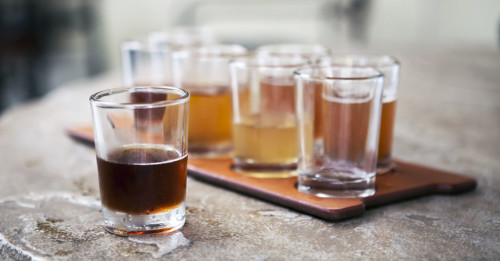Drinking beer might seem like an easy thing. So easy, in fact, that people even began doing it upside down, designing hats around it, and combining it with ping pong sports.
But things have changed. The craft beer renaissance has brought attention to a new spectrum of meticulously crafted beers—and renewed attention to classic beer styles that, at least for a while, took a backseat to the output of commercial beer giants. By now most of us know drinking beer isn’t a simple thing, nor should it be. Casual, maybe. Fun, absolutely. But simple, never.
The taste of a beer is really made up of several components, the most important of which are aromatics, flavor, and mouthfeel. (Sure, there’s some overlap there, but bear with us.) The best way to taste a beer is to allow each of these elements to influence your experience.
Flavors and aromatics—in beer as in everything we eat or drink—are hopelessly, delightfully intertwined. What we smell from a glass of beer is going to influence how we taste the beer. And depending on the style of beer at play, flavors and aromatics can range all across the map—florals, pepper, citrus, bread, raisin, chocolate, pine, grass, toffee, banana, earth, nuts, biscuit, coffee, cloves, tropical fruit, etc. The list goes on, as far as your ability to conjure up adjectives.
But understanding other elements—especially mouthfeel—can open up your experience of “taste” to a whole new level. So what is mouthfeel, besides a word that someone clearly (and cleverly) made up by smashing two other words together? It’s kind of exactly what it sounds like: the feeling of the beer in your mouth, which involves elements like texture, pH level, carbonation, ABV and serving temperature. Like most things in beer, mouthfeel will vary heavily depending on beer style. A stout is going to taste thicker than a crisp lager, but two IPAs will likely have fairly similar mouthfeels (even if things like flavor and aromatics are different, resulting from different use of hops).
So now that you know what to look for, how should you actually taste a beer? The rules are very similar for beer as wine: look, smell, and only then, taste. Perceive the beer’s color and apparent structure, and then agitate the beer to release aromatics. When it’s finally time to taste, take a sip or two to prime your palate, and then (finally!) it’s time to take your tasting sip. Don’t chug, or even swallow just yet! Get a sense for the beer’s mouthfeel and, if you’re really into digging into flavor appreciation here, exhale a bit while you taste and try to perceive those aromatics as you exhale (called retro-olfaction). Remember, the point isn’t scientific precision. The point is enjoyment, enhanced with a bit of knowledge.
